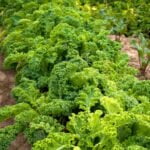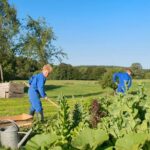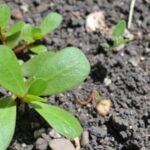Vegetable gardening is a rewarding and fulfilling activity that allows individuals to cultivate their own fresh produce, connect with nature, and promote sustainability. Whether you’re a beginner or an experienced gardener, having the right guidance is essential for success in your vegetable garden. This is where vegetable best gardening books come into play, offering valuable insights, tips, and techniques to help you maximize your garden’s potential.
These gardening books not only provide practical advice on planting, maintenance, and harvesting but also inspire creativity and passion for growing your own vegetables. They are essential tools that can help you navigate the challenges of gardening while enhancing your overall experience. From traditional methods to innovative approaches, these books cover a wide range of topics to cater to every gardener’s needs and preferences.
By investing in quality vegetable gardening books, you can gain valuable knowledge from experienced authors, learn new skills, troubleshoot common problems, and ultimately achieve a bountiful harvest. Whether you’re looking to start a small backyard garden or expand your existing plot, these books offer a wealth of information that can guide you towards success.
In the following sections, we will explore the top 5 best vegetable gardening books recommended by experts in the field, as well as provide insights into beginner’s guides, advanced techniques, organic practices, troubleshooting tips, seasonal gardening advice, and additional resources for further reading.
Top 5 Best Vegetable Gardening Books
When it comes to vegetable gardening, having the right resources can make a huge difference in the success of your garden. One of the most essential resources for any gardener is a good gardening book. There are many great books out there that can provide valuable information, tips, and guidance for growing your own vegetables. Here are the top 5 best vegetable gardening books that every gardener should consider adding to their collection:
1. “The Vegetable Gardener’s Bible” by Edward C. Smith – This comprehensive guide covers everything you need to know about growing vegetables, from soil preparation to plant care to harvesting. Edward C. Smith’s easy-to-follow instructions and insightful tips make this book a must-have for beginner and experienced gardeners alike.
2. “Square Foot Gardening” by Mel Bartholomew – Mel Bartholomew revolutionized vegetable gardening with his square foot gardening method, which maximizes space and productivity in small gardens. This book provides a step-by-step guide to creating and maintaining your own square foot garden, making it perfect for urban gardeners or those with limited space.
3. “Carrots Love Tomatoes” by Louise Riotte – If you’re interested in companion planting and natural pest control methods, this book is a must-read. Louise Riotte delves into the world of companion planting and explores how different plants can benefit each other when grown together. This insightful guide is a great resource for gardeners looking to boost their harvest organically.
4. “Rodale’s Basic Organic Gardening” by Deborah L Martin – For those interested in organic gardening practices, this book is an essential read. Deborah L Martin covers all the basics of organic gardening, from soil health to pest management, making it easy for gardeners to transition to chemical-free growing methods.
5. “The New Organic Grower” by Eliot Coleman – Eliot Coleman is a renowned expert in organic farming and his book offers advanced techniques for seasoned gardeners looking to up their game. From crop rotation strategies to season extension tactics, this book provides valuable insights that can help take your vegetable gardening skills to the next level.
All of these books come highly recommended for vegetable gardeners looking to improve their knowledge and skills in growing their own fresh produce organically.
- “The Vegetable Gardener’s Bible” by Edward C Smith
- “Square Foot Gardening” by Mel Bartholomew
- “Carrots Love Tomatoes” by Louise Riotte
- “Rodale’s Basic Organic Gardening” by Deborah L Martin
- “The New Organic Grower” by Eliot Coleman
Beginner’s Guide to Vegetable Gardening
Vegetable gardening is a rewarding and fulfilling activity that allows individuals to grow their own fresh produce right at home. For beginners looking to start their own vegetable garden, having the right guidance is essential for success. One of the best ways to get started on the right foot is by utilizing gardening books specifically tailored for vegetable gardening. These books provide valuable information, tips, and tricks that can help beginners navigate the world of vegetable gardening with confidence.
Here are some essential tips and tricks for beginners venturing into vegetable gardening:
1. Essential Tools: Having the right tools can make a significant difference in your gardening experience. Some must-have tools for vegetable gardening include a shovel, trowel, pruning shears, watering can or hose, gloves, and a garden fork. Investing in quality tools will make tasks easier and more efficient.
2. Soil Preparation: Healthy soil is the foundation of a successful vegetable garden. Before planting, it’s important to test your soil’s pH level and composition to determine if any amendments are needed. Adding organic matter like compost or aged manure can improve soil structure, fertility, and drainage.
3. Planning: Proper planning is key to a productive vegetable garden. Consider factors such as sunlight exposure, spacing between plants, water availability, and plant compatibility when designing your garden layout. Creating a planting schedule based on the growing season in your region will help you maximize harvests throughout the year.
Avoiding common mistakes can save time and resources in the long run:
– Overcrowding plants: Giving plants enough space to grow ensures proper airflow and reduces competition for nutrients.
– Neglecting watering: Consistent watering is crucial for healthy plant growth. Monitor soil moisture levels regularly and adjust watering frequency as needed.
– Skipping pest control: Keeping an eye out for pests and diseases early on can prevent widespread infestations that may harm your plants.
– Failing to rotate crops: Crop rotation helps prevent soil depletion and minimize pest problems by disrupting their life cycles.
By following these tips and avoiding common mistakes, beginners can set themselves up for a successful vegetable gardening journey. Additionally, referring to beginner-friendly vegetable gardening books like “The Vegetable Gardener’s Bible” by Edward C. Smith or “Square Foot Gardening” by Mel Bartholomew can provide valuable insights and guidance every step of the way toward creating a bountiful vegetable garden.
Advanced Techniques
Advanced gardening techniques can take your vegetable garden to the next level, ensuring healthier plants and higher yields. One such technique is companion planting, where certain plants are grown together to benefit each other in various ways. For example, planting basil near tomatoes can help repel pests and improve tomato growth.
Another advanced technique is succession planting, which involves planting different crops in the same space throughout the growing season to maximize harvests. This ensures a continuous supply of fresh produce rather than a single large harvest.
Crop rotation is another vital aspect of advanced vegetable gardening. Rotating crops helps prevent soil depletion and nutrient imbalances by alternating plant families in specific areas each season. This practice minimizes the risk of pest and disease buildup while improving soil structure and fertility.
By following a strategic crop rotation plan, experienced gardeners can maintain a healthy and productive garden year after year. Additionally, intercropping – planting different types of plants closely together in the same area – can also be an effective technique for maximizing space, minimizing weeds, and promoting biodiversity in the garden.
Companion Planting
Companion planting is not just about finding good neighbors for your vegetables but also about providing natural pest control and fostering healthier soil conditions in your garden. By understanding which plants complement each other, gardeners can create a symbiotic relationship that benefits all plants involved while reducing the need for chemical interventions. For example, planting marigolds alongside vegetables like tomatoes or squash can deter harmful insects due to their strong scent.
Crop Rotation
Crop rotation involves changing the location of plant families within the garden each year to prevent diseases and pests from building up in the soil. By categorizing vegetables into different groups based on their nutrient needs and potential pests or diseases they attract, gardeners can strategically rotate crops to maintain soil health and balance over time. This practice also helps break cycles of plant-specific pathogens that could persist if the same crop is planted in the same spot repeatedly.
Organic Gardening
One highly recommended book for organic gardening enthusiasts is “The Vegetable Gardener’s Bible” by Edward C. Smith. This comprehensive guide offers practical advice on all aspects of organic vegetable gardening, from soil preparation and composting to plant selection and pest control. Smith’s approach emphasizes building healthy soils, using natural fertilizers, and integrating companion planting techniques for a productive and eco-friendly garden.
Another excellent resource for organic vegetable gardening is “Rodale’s Basic Organic Gardening” by Deborah L. Martin. This book covers the basics of organic gardening, including choosing the right plants for your climate, preventing common pests naturally, and utilizing sustainable practices to promote long-term soil health. Martin’s easy-to-follow instructions make this book ideal for beginners looking to embrace organic growing methods for their vegetable garden.
For those interested in delving deeper into the science behind organic gardening practices, “Teaming with Microbes: The Organic Gardener’s Guide to the Soil Food Web” by Jeff Lowenfels and Wayne Lewis is a must-read. This groundbreaking book explains how soil microorganisms play a crucial role in supporting plant health and productivity in an organic garden. By understanding the complex relationship between plants, soil, and microbes, gardeners can optimize soil fertility without relying on synthetic fertilizers or pesticides.
Troubleshooting Guide
When embarking on a vegetable gardening journey, it is essential to be prepared for the various challenges that may arise along the way. From pesky pests to stubborn diseases and unpredictable weather conditions, there are numerous obstacles that gardeners may encounter.
However, with the right knowledge and resources at hand, these issues can be effectively addressed and managed. In this section, we will explore common problems in vegetable gardening and provide valuable insights on how to solve them, including recommendations for books that delve into pest control, diseases, and environmental issues.
Pest Control
One of the most significant challenges that vegetable gardeners face is dealing with unwanted pests that can wreak havoc on their crops. From aphids and caterpillars to deer and rodents, there is a wide range of pests that can threaten the health of your plants.
To effectively combat these pests and protect your vegetables, it is crucial to have a solid understanding of integrated pest management techniques. Books such as “The Vegetable Gardener’s Guide to Pest Control” by Barbara Pleasant offer valuable insights on identifying common garden pests, implementing preventive measures, and utilizing organic solutions for pest control.
Diseases
Another common issue in vegetable gardening is the occurrence of plant diseases caused by fungi, bacteria, viruses, or environmental factors. Diseases such as powdery mildew, blight, and root rot can quickly spread throughout your garden if left unchecked.
To prevent and manage these diseases, it is essential to practice good hygiene habits, ensure proper air circulation around plants, and use disease-resistant varieties. Books like “The Vegetable Gardener’s Bible” by Edward C. Smith provide in-depth guidance on diagnosing plant diseases, implementing cultural practices to minimize risks, and using natural remedies to treat infected plants.
Environmental Issues
In addition to pests and diseases, vegetable gardeners also need to be vigilant about potential environmental issues that can impact their gardens. Factors such as soil quality, water management, temperature fluctuations, and exposure to pollutants can all affect the health and productivity of your plants.
Understanding how these environmental factors influence your garden can help you make informed decisions about soil amendments, irrigation methods, planting schedules, and more. Books like “Teaming with Microbes: The Organic Gardener’s Guide to the Soil Food Web” by Jeff Lowenfels provide valuable information on building healthy soil ecosystems that support vibrant plant growth while minimizing environmental risks.
Seasonal Gardening
- Planting Schedules: One of the key factors in seasonal gardening is following the correct planting schedules for each season. Different vegetables thrive in specific temperatures and sunlight conditions, so it’s important to plan your planting timeline accordingly. For example, cool-season crops like broccoli and lettuce are best planted in early spring or late summer, while warm-season crops like tomatoes and peppers are typically planted after the last frost date in spring.
- Care Tips: Each season requires different care techniques to ensure the health and vitality of your vegetable garden. In the spring, focus on preparing your soil with compost and nutrients to support new growth. Summer requires consistent watering and mulching to retain moisture in the soil during hot temperatures. Fall is a time for harvesting mature crops and protecting delicate plants from frost as winter approaches.
- Harvest Guides: Harvesting your vegetables at the right time is essential for optimal flavor and nutrition. Different vegetables have specific signs that indicate they are ready for harvest, such as color changes or firmness. Understanding these signals can help you avoid harvesting too early or too late. Additionally, proper storage techniques can extend the shelf life of your harvested produce, allowing you to enjoy fresh vegetables even after the growing season ends.
| Seasonal Gardening Tips | Recommendation |
|---|---|
| Spring Planting Schedule | Best Vegetable Gardening Books by Jessica Smith |
| Summer Care Tips | Gardening Techniques by John Green |
| Fall Harvest Guide | Organic Gardening: A Seasonal Approach by Sarah Wilson |
Resources and Additional Reading
When it comes to vegetable gardening, there are endless opportunities to learn and improve your skills. While the top 5 best vegetable gardening books provide invaluable guidance and insights, there are numerous other resources available for gardeners looking to further expand their knowledge. Whether you are a beginner looking for basic tips or an experienced gardener seeking advanced techniques, the right resources can make a significant difference in the success of your garden.
In addition to books, there are also various websites and online resources that offer valuable information on vegetable gardening. Websites such as The Spruce, Gardening Know How, and Mother Earth News provide articles, tutorials, and forums where gardeners can exchange ideas and seek advice.
Online gardening communities can be a great place to connect with fellow enthusiasts, ask questions, and share experiences. Additionally, many universities and extension offices offer online courses and webinars on topics ranging from pest management to soil health.
As you continue on your vegetable gardening journey, remember that learning is a never-ending process. Take advantage of the resources available to you – whether it’s through books, websites, or local gardening clubs – to deepen your understanding of plant care, pest control, soil health, and more. By staying informed and open to new ideas, you can enhance your skills as a vegetable gardener and enjoy bountiful harvests for years to come.
Frequently Asked Questions
What Is the Best Gardening Book for Beginners?
The best gardening book for beginners is often subjective, as it depends on personal preferences and gardening goals. However, a popular choice among novice gardeners is “The Vegetable Gardener’s Bible” by Edward C. Smith. This book provides comprehensive information on growing vegetables, from seed to harvest, in an easy-to-understand format.
What Is the Most Suitable for Vegetable Gardening?
When it comes to vegetable gardening, the most suitable option depends on various factors such as space availability, sunlight exposure, and soil quality. Raised beds are commonly recommended for vegetable gardening as they offer good drainage, better soil control, and easier maintenance compared to traditional in-ground planting.
Additionally, raised beds can help extend the growing season by providing warmer soil temperatures early in the season.
What Is the Best Vegetable Garden Configuration?
The best vegetable garden configuration will depend on factors like available space, sunlight exposure, and personal preferences. One common layout is the square foot gardening method popularized by Mel Bartholomew. This approach divides the garden into square-foot grids to maximize space efficiency while making it easy to plan and maintain different varieties of vegetables in a small area.
Another popular configuration is the companion planting method where compatible plants are grown together to enhance growth and deter pests naturally. Ultimately, the best vegetable garden configuration is one that suits your specific needs and gardening style.

If you’re looking to get into vegetable gardening, or are just looking for some tips on how to make your current garden better, then you’ve come to the right place! My name is Ethel and I have been gardening for years. In this blog, I’m going to share with you some of my best tips on how to create a successful vegetable garden.





